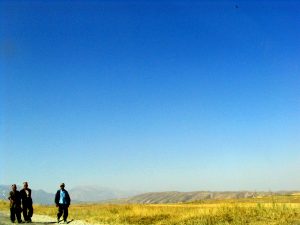Kyrgyzstan and Uzbekistan’s long-running border dispute has been, according to Kyrgyz authorities, finally put to rest.
Late last week, chairman of Kyrgyzstan’s State Committee for National Security (SCNS or GKNB) Kamchybek Tashiev said, “Issues around the Kyrgyz-Uzbek border have been resolved 100 percent. We have tackled this difficult task. There is not a single patch of disputed territory left.”
He’d just returned to Bishkek after leading a delegation for talks in Tashkent on March 24-25. That delegation came close on the heels of Kyrgyz President Sadyr Japarov’s March 11-12 state visit to Uzbekistan. The border matter was raised during Japarov’s visit with Uzbek President Shavkat Mirziyoyev and progress was reportedly made during Tashiev’s visit, during which he met with a group of Uzbek officials led by Prime Minister Abdulla Aripov.
The two sides signed a protocol on the final delimitation and demarcation of the Kyrgyz-Uzbek border. The agreement contains a number of land swaps, with Kyrgyzstan coming out with more territory, offset by continued Uzbek use of reservoirs on Kyrgyz land.
One reservoir in particular, the Orto-Tokoi (Kasan-Sai) reservoir, has been at the center of heated debate for decades. As Eurasianet explained back in 2016, as a flash of tensions in the area abated:
This area has been a source of contention between Uzbekistan and Kyrgyzstan since the 1930s, when both sides were nascent Soviet republics. With the growing importance of the cotton industry to the economy of Uzbekistan’s Ferghana Valley, Moscow ordered that the Kyrgyz Soviet government allocate large quantities of its water resources to its neighbor. In the early 1940s, 660 hectares of land were transferred to Uzbekistan for the construction of the reservoir, which was completed in 1954
Uzbekistan enlarged the reservoir in 1972 and provided the Kyrgyz SSR with land as compensation. Rival territorial claims resumed in 1991 as both sides claimed ownership of the reservoir.
In the fall of 2017, Kyrgyzstan and Uzbekistan signed an agreement regarding the reservoir in which Bishkek was granted control but both countries permitted access. Uzbekistan, in that agreement, came out with rights to most of the water for irrigation. The latest agreements seem to keep that arrangement, but compensate Kyrgyzstan with land swaps in disputed areas.
Per 24.kg, quoting Tashiev:
“As you know, Orto-Tokoi reservoir was used by Uzbekistan by 95 percent. In accordance with the agreement, they had to transfer us a land plot equal to the area of the reservoir — more than 700 hectares — as compensation. About 200 hectares have already been transferred, 500 remained. Thanks to the reservoir, we received several disputable areas: Kok-Serek — 105 hectares, Bayastan — 212 hectares, Ak-Tash — 100 hectares, Ungar-Too — 35 hectares, Kara-Beles — 25 hectares.”
Ungar-Too, a mountain that has also featured in previous tensions, will be marked as Kyrgyz territory, with the border at its base.
Another reservoir, the Kempir-Abad reservoir located in Osh region, will be jointly used.
Negotiations also touched on the matter of Sokh, an Uzbek exclave surrounded by Kyrgyz territory. The recent agreement commits both sides to opening checkpoints for cars and minibuses that should simplify the process of travel between the exclave and the main portion of Uzbekistan for the 85,000 Uzbek citizens who live there.
With the protocol signed settling the remaining border issues, the next phases are critical. The two sides must consider and adopt the agreement in the next few months and “conduct explanatory work among the population.” That last bit is the touchiest. As Kyrgyzstan and Uzbekistan move from agreeing on paper to where their border lies, or delimitation, they will have to take up the nastier matter of demarcation — or physically marking the border. That process may trigger tensions at the local level, especially when swapped territory comes into play.
If this push proves successful, Kyrgyzstan will have settled borders with three of its four neighbors: China, Kazakhstan, and Uzbekistan. That will leave Tajikistan to deal with. According to RFE/RL’s Kyrgyz Service, only about 60 percent of the Kyrgyz-Tajik border has been settled. Tashiev cited the Vorukh exclave (Tajik territory surrounded by Kyrgyzstan) as a main stumbling block in settling the remaining border sections with Dushanbe. He proposed two options: the opening of a road from Vorukh to Tajikistan bypassing the Kyrgyz village of Ak-Sai or a land swap for territory along the border in Batken in Kyrgyzstan. Dushanbe has reportedly not responded to the proposition.

































